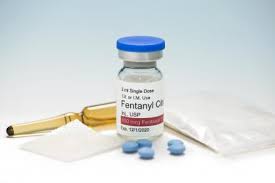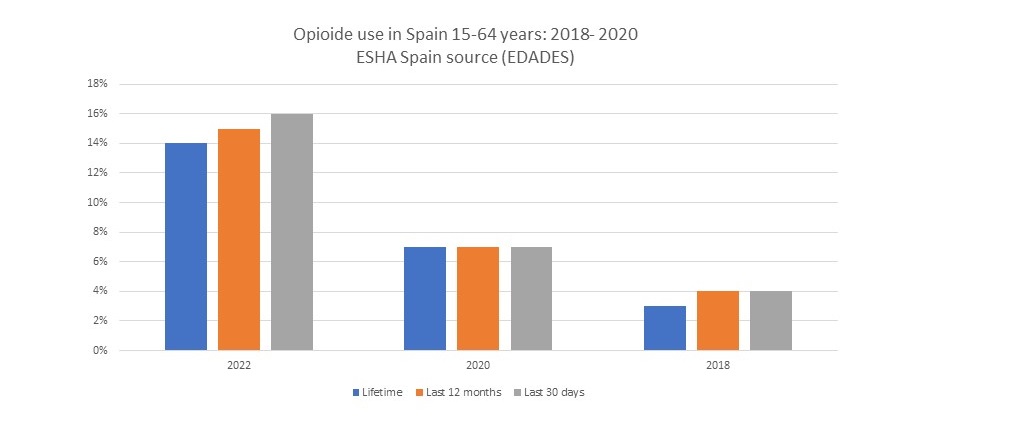
Fentanyl Use Increases in Spain
In 2022, the number of adults in Spain who had consumed fentanyl at least once in their lifetime has multiplied eightfold compared to 2018
Fentanyl, a substance 50 times more potent than heroin and 100 times more so than morphine according to the U.S. Centers for Disease Control and Prevention (CDC), is increasingly consumed in Spain due to the expansion of its medical use, as experts explain. In fact, the number of people between the ages of 15 and 64 who had taken it at least once in 2018 has multiplied by eight, going from 0.3% to 2.2% of the population in 2022, according to calculations from the latest survey on alcohol and drugs in Spain (EDADES) published by the Ministry of Health.
Although its typical use is medical, as it is used as an analgesic for cases where more common medications are not sufficient to alleviate pain, its addictive potential and the ability to generate well-being and relief in those who consume it, has resulted in its alarming popularity as a narcotic in countries like the United States. There, in 2021 about 70,000 deaths were recorded from the consumption of opioids—excluding methadone—mainly fentanyl, according to data from the National Institute on Drug Abuse (NIDA).
In Spain, 2.2% of people between 15 and 64 years old have consumed fentanyl at least once. Fentanyl is a type of opioid that is used “as an analgesic and anesthetic,” according to the World Health Organization (WHO). Although it is used in this way for medical treatments, under health control, its external consumption can lead to addiction.

In Spain, 15.8% of people between 15 and 64 years old have consumed opioid substances at least once, according to EDADES data for 2022. This percentage of the total population has grown by 1.3 points compared to 2018, and while tramadol and codeine are the most common substances among those who have consumed opioids at least once—including their medical uses—the prevalence of fentanyl has risen in the last four years.
Consumption of fentanyl in particular among opioid consumers has gone from 1.9% in 2018 (about 84,000 people, 0.27% of the total population of 15 to 64 years) to 14% in 2022 (about 695,000 people, 2.2% of the population from 15 to 64 years), i.e., eight times more.
In 2018, the Spanish Agency of Medicines and Medical Devices (AEMPS) warned of the increase in the use of fentanyl-containing medicines and expressed their “concern about the risk of abuse and dependence for patients”. For this reason, as Kiko Toja, specialist in Hospital Pharmacy, points out, its use is very controlled in Spain and not only requires a medical prescription, but also an inspection visa issued by a specialist in Hospital Pharmacy. “In our country, acquiring these drugs legally for use as abuse substances is very complicated,” he assures.
Fentanyl Consumption Increase in Spain, Derived from Its Medical Use
The pharmaceutical development of fentanyl has allowed the diffusion of its medical use beyond hospitals, as María Cristina Núñez Parra, a professor of Pharmacology at the University of Murcia, and the principal investigator of the Cellular and Molecular Pharmacology Research Group, explained to journalists.
Previously, due to the risk of overdose — “the amount of fentanyl that can cause death is much smaller than that of morphine (about 100 times less),” according to the expert— it was only administered in hospitals. However, now there are more controlled ways to administer this medication, such as transdermal patches, “kind of ‘strips’ that contain the drug (…) and allow it to enter the body at a low and controlled dose.”
In addition, Fentanyl is a cheap additive that traffickers can use to potentiate their products, giving greater addictive potential. Meaning that potential users are consuming unknown substances
This poses a significant risk of overdose, as its potency means that “small variations in the amount of fentanyl cause large differences in the intensity of its effects” and the consumer “has no way of knowing the amount of fentanyl with which they are getting high.”
However, the Ministry of Health points out that fentanyl “has not so far posed the same problems in Europe as in North America”.
What is Fentanyl and What Are Its Effects
Fentanyl is an opioid drug used to treat severe pain, such as advanced cancer pain. It is part of the family of drugs known as opioids, which also includes drugs like morphine and heroin. Fentanyl is highly potent, and it is often prescribed when other pain medications are no longer effective.
The effects of fentanyl are similar to other opioid drugs and include euphoria, relaxation, and drowsiness. However, it can also cause serious health effects, such as slowed or stopped breathing, lowered pulse and blood pressure, nausea, confusion, constipation, sedation, unconsciousness, and even death.
Fentanyl is highly addictive, and misuse of this drug—such as taking it without a prescription or in higher doses than prescribed—can lead to addiction, overdose, or death, especially when mixed with other drugs such as alcohol.
Risks and Warnings
The increased use and availability of fentanyl in Spain are cause for concern. Even when used as prescribed, fentanyl can cause serious harm, and misuse can lead to tragic consequences.
Despite the more controlled medical use of fentanyl in Spain, the risk of illegal use and addiction remains. It is important for healthcare providers to closely monitor patients taking fentanyl and for individuals to understand the risks associated with its use.
The Spanish Agency of Medicines and Medical Devices (AEMPS) and the Ministry of Health have issued warnings about the risk of abuse and addiction associated with fentanyl. These agencies continue to monitor the situation and are working to prevent misuse and addiction.
Conclusions
The rise in fentanyl use in Spain, largely attributed to its expanded medical use, is a complex issue. While the drug has important medical applications, its potency and addictive potential make it a significant public health concern.
As fentanyl use continues to increase, it is essential for healthcare providers, patients, and the public to be aware of the risks associated with this powerful opioid. Ongoing research, education, and prevention efforts are needed to address this growing concern.
If you are concerned about your own, or someone you know’s drug use, you can find a list of English-Speaking healthcare professionals in the ESHA Spain business directory
References
Comunicación del Ministerio de Sanidad
Encuesta sobre alcohol y drogas en España (EDADES) 2022 publicada por el Ministerio de Sanidad
Información sobre sobredosis de opioides de la Organización Mundial de la Salud (OMS)
Leave a reply





Leave a reply